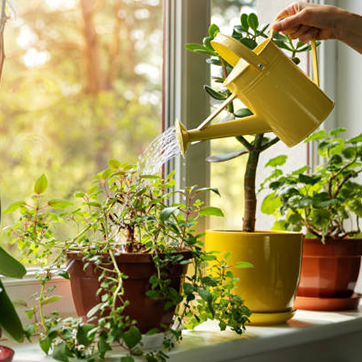This Is How You Water Plants
Watering is the most important garden operation and it is where we frequently go wrong.Watering should be done only when required and then it must be thorough.Golden rule for watering plants: Touch the soil with your finger. If the soil feels dry, then water thoroughly. It there is some moisture in the soil, then refrain from watering. If you are still not sure, then err on the side of over-watering in the summer and under-watering in the winter. Water must come out of the hole at the bottom if the plant has been watered thoroughly.Watering should be done as though it is raining on the plants. Water should not be given with a hose WITHOUT a sprinkler. It should not be given with such a force that it washes away the precious topsoil. Water sprayers create a mist effect which is therapeutic for plants.Regular Garden Shower available on amazon, sold by YUVISMART is a must for any garden, balcony or terrace.
Indoor plants need even less watering because the soil does not get a chance to dry out. But use of fans and air conditioners dehydrate the plants. In order to prevent this, spray your plants every day. Did you know that plants die due to over-watering than anything else...we are deathly afraid of under-watering our plants and as a result many of us tend to over-water.What do our maalis do... they come and they only water the plants. And the water will be flowing with such force that the precious top soil will get eroded...But the hanging baskets which are out of reach won’t get watered and the plants in the far corner won’t get watered either.The best thing you can do to keep your plant healthy is to water it correctly. In fact when employing a maali tell him he can only water every alternate day and must do other garden operations other days. So he must turn the soil one day, remove the dead leaves on other days, spray NPK once a week, do some debudding or gentle trimming once a week..It’s only in the heigt of summer that watering has to be done every single day. And small plants and seasonal flowers need watering almost every day.If we water our plants ourselves we will realise what little time and effort it involves...In fact when employing a maali tell him he can only water every alternate day and must do other garden operations other days. So he must turn the soil one day, remove the dead leaves on other days, spray NPK once a week, do some debudding or gentle trimming once a week.. Watering your plant sounds so simple, fill your watering can and empty it above your plant pot. But as soon as you bring a plant into your home, you soon find out that it's not always that simple. Too much water and your plant will drown, too little water and you will see the leaves shrivel. And how exactly do you water, do you follow a fixed schedule or do you check your plants every day? How do you recognize that a plant has received too little or too much water and what can you do about it if that has happened? All these questions about watering your houseplants are answered in this blog.
Collapsible content

How much water does your plant need?
In this blog you will learn how to get to know your plant and its water needs, but you will not find exactly how many milliliters of water your plant needs. That depends on many factors and also changes during the year. How much water your plant consumes depends, among other things, on the season, the amount of light your plant receives, the temperature, humidity and the relationship between the size of the pot and the size of your plant. In short, it is important that you learn what your plant needs. Fortunately, it is easy and also fun.
How often do you water a plant?
It is logical that not every plant needs the same amount of water, some plants grow naturally in very dry areas and others in very humid places. At home you want to imitate the natural situation as much as possible. Some plants have enough water with once every two weeks or even less, others sometimes want to be watered twice a week. You can roughly divide the different water needs into three categories.
What if you have given too much water?
Too much water will not make any plant happy. It ensures that too little air reaches the roots of your plant, causing them to rot. For some plants this means the end, for example a cactus that has received too much water can suddenly collapse completely. Or the stem of your succulent plant turns out to be completely rotten. These plants can no longer be saved. Many other plants can still be saved.The first signs of an overwatered plant are leaves turning yellow . Often these are yellow spots, which are soft to the touch. These spots will enlarge and eventually the leaves will fall off your plant. Are you worried that you have given too much water? Then remove your plant from the pot and check the soil. If it feels wet, then you know for sure that you have given too much water. Save your plant by removing the wet soil from the roots and checking whether they are still healthy. Healthy roots feel firm, where rotting roots are snotty. After you have cut away the snotty roots, you can put your plant back with fresh potting soil. Give it time to recover and of course don't water so much anymore.
What if you don't water your plant enough?
Many plants can do better if you give just a little too little water than if you give too much water. Plants can recover more easily from too little water than from too much water. You can often recognize a plant that gets too little water by its leaves. Sometimes they droop a bit, they feel a bit less firm or they become a bit duller in color. In extreme cases, the leaves will shrivel and fall off the plant. Some plants are huge divas that hang very dramatically and with other plants you can hardly see a difference. For example, a succulent or cactus will subtly wrinkle if it gets too little water. If you see signs that your plant is low on water, check the soil, run to the tap and water your plant. With most plants you will see a difference after a few hours, the leaves will feel firm again and will stand up again. Is the soil so dry that the water immediately runs out of the holes in the plastic pot? Then it is best to place your plant in a container with water. Allow the soil to absorb water for at least half an hour, so that the soil retains moisture well again. Then you let your plant drain for a while and put it back.
Get to know your plant
The most important thing when watering your plant is that you know which category your plant falls into. Should the soil always remain moist, or should it dry out? If you check the soil first every time you water, you and your houseplant will certainly be fine. You will quickly see how much water it uses and you will also notice the difference between water consumption in winter and summer. This way you never have to hesitate again when you stand next to your plant with your full watering can .

